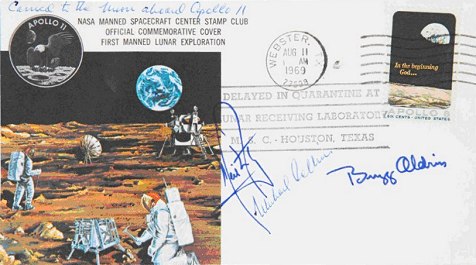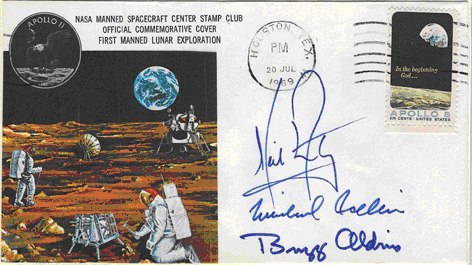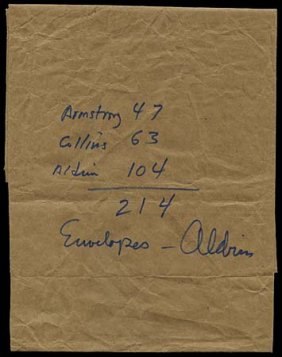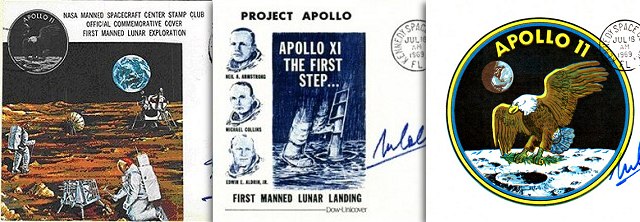|
The three man crew of Apollo 11, commander Neil Armstrong, lunar module pilot Edwin "Buzz" Aldrin and command module pilot Michael Collins, were the first to land man on a another planetary body. The crew was fully aware of the historic significance of their mission and brought along a few commemorative mementos for family, friends and themselves. Among the most desirable of those mementos were 214 crew signed envelopes that commemorated the mission.
There were three differently designed covers among the 214 that were flown; The large Apollo 11 mission emblem cover, the Project Apollo DowUnicover, and the NASA Manned Spacecraft Center Stamp Club cover, which was adorned with a colorful cache of men working on the Moon and the Apollo 11 mission logo.
Although exact numbers of how many of each design were flown is not certain, auction records show that the majority of the covers were of the NASA Manned Spacecraft Center Stamp Club variety.
While in pre-flight quarantine in crew quarters some weeks before the mission, in-between further training, the crew would autograph these envelopes, further completing their creations.

One of Michael Collins' Apollo 11 flown covers
In addition to the flown covers, during the same time, the crew would also sign a number of similar covers that would be left at home with their families, to be used in the event that the crew did not return from the mission. These became known as the insurance covers. As command module pilot Michael Collins would tell, "These covers were currency to our families in the event that we did not return."

Apollo 11 Type 1 Insurance Cover
When I asked Michael Collins how many insurance covers existed, he said that he could not confirm the exact number but that his recollection was about 1000, which were divided equally for each family.
He also shared an interesting nuance about differences between the flown and insurance covers. The insurance covers were signed to take up all the available space in the open field on the cover while the flown covers were deliberately signed across a straight line in the middle of the cover, in order to leave space for them to put the name of a family member or friend who they would present one too.

Aldrin notated paper bag that kept the
Apollo 11 flown covers together
The 214 flown covers were shared among the crew in the following breakdown: Armstrong : 47 ; Collins : 63 ; Aldrin : 104.
Each of the astronauts devised their own serial numbering key for their covers. Aldrin noted each cover in the top left corner with his initials and a number (e.g. EEA-1 and some A-?), Collins noted his covers within the image of the earth on the front with his last name initial and a number (e.g. C-59).
[Webmaster's note: the following 3 paragraphs have been revised subsequent to the sale of an Armstrong Apollo 11 cover in 2018]
Looking at the covers that have surfaced for sale over the last 20 years, it appears that after marking at least 52 covers EEA-? Aldrin switched to A-?, as evidenced by covers A-58, A-63, A-70, and A-73.
With 104 covers to initial in total, Aldrin was likely tiring of numbering and writing on all of these covers and could have elected to simplify in order to get the task done faster.
Or perhaps he managed the task in two batches of around 52 covers and elected to use a simpler style when starting the second batch.
Prior to 2018 no covers from Armstrong had ever been offer to market and it had been confirmed that he was still in possession of all 47, with none having been distributed or destroyed.
The first cover to be offered showed that they were marked "CARRIED TO THE MOON ON APOLLO 11" along with his initials and a number (e.g. NA-1).
The flown covers are affixed with either a Scott 1371 six-cent postage stamp, which depicts the Apollo 8 Earthrise and the words "In the beginning God..." or a Scott 1338 six-cent postage stamp, which depicts the US flag over White House. All the covers have the Webster, TX August 11, 1969 post office cancellation and the Lunar Receiving Laboratory quarantine stamp. Aldrin and Collins hand wrote above the cachet on each of their covers "Carried to the Moon aboard Apollo 11", while it is not known if and how Armstrong notated his.
The significance of the August 11 postmark is that it was the time items began to be released from quarantine.
In terms of market analysis and the potential future values of these covers, one can expect that they will remain among the most desirable and costly. Can you imagine the value of an artifact from Christopher Columbus' voyage in 1492 that was accompanied by a signed certification letter by him attesting to what it is? Well, these covers flew aboard an expedition as great or greater than the Columbus voyage and are certified by the crew themselves, so I expect that they will continue to become more popular as more people learn that they exist.
All flown Apollo 11 items are valuable and in demand, however, many items are generic, which are more difficult to certify. The items that commemorate the mission, like Robbins Medals, flown covers, beta cloths and mission patches will stay atop the desirability list because they depict the mission emblem and require little explanation. Of these, the flown covers really do exemplify the ideal rarity because they incorporate all of the desired elements; the commemorative aspect, the flown status, the quarantine time, the crew signatures and the scarcity of only 214 having existed.
The flown covers have surfaced from time to time at auction since the 1990s and have fetched prices in a wide range from approximately $20,000 to $46,000. We do not know how many of these covers were given away by the crew, so it is possible that covers might, at some point, be offered by third party consignors who may have been the recipient or from their heirs. In these cases, it is likely that the cover would be offered without any crew certification. And although these would be undeniably genuine, if a cover were to be offered with an additional separate signed letter from one of the crewmembers confirming serial number, flown status and from their collection, I expect that it would command a further premium.
The last 20 years has certainly seen a great evolution in the understanding of rarities; whether its how to identify and preserve them, or in truly understanding what makes one great and rare. The idea of certifications was virtually non-existent just a few years ago and now pedigree and provenance can make the difference in the desirability of something. The Internet has also played a key role in leveling the playing field like never before possible, as novice and expert become equal at the touch of a key. The evolution has made collectors smarter as they now have access to honest information, whereas previously, dealers controlled much of what collectors could know, which allowed manipulation. This knowledge has helped to broaden the general collector base and made markets more liquid, which has also brought investors into many of the rarities markets.
Houston, the Eagle has landed!

Shown above are the three different cachets known to have been flown on Apollo 11 and/or used as insurance covers.
From left to right: MSC Stamp Club (Type 1) ; Dow-Unicover (Type 2) ; Mission Emblem (Type 3)
|